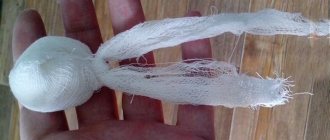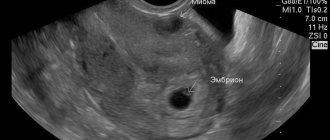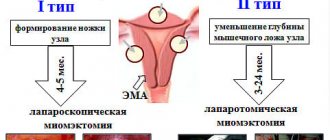Benign uterine tumors occur in 20-40% of women of reproductive age. It is a common indication for hysterectomy, but at an early stage the pathology is eliminated with medication. To treat uterine fibroids with medications, the doctor chooses the drugs depending on the severity and the presence of concomitant complications that affect the patient’s health.
What is fibroid?
Myoma is a neoplasm that is classified as a benign neoplasm.
These tumors grow in the area, as a rule, of the walls of the cervix or the walls of the uterus itself. The growth process can be carried out either by a certain number of millimeters or reach sizes in centimeters. Very often, women experience the formation of multiple types of fibroids.
Multiple type fibroids have the form of several neoplasms. Myoma is also called fibromyoma and leiomyoma.
Prevention
The main reason for the formation of a benign nodular tumor in the uterus is hormonal imbalance. Many reasons can worsen hormonal levels. If you remove them or minimize them, you will be able to avoid the appearance of a tumor. How to prevent the disease:
- Treatment of infectious and chronic pathologies. Advanced disease, especially gynecological disease, often leads to the formation of fibroids.
- Prevention of abortions. Termination of pregnancy artificially is a great stress for the body, which leads to changes in hormones.
- Regular sex life, having a child under 30 years of age and lactation
- Exercise. Regular physical activity prevents disruption of blood supply to the pelvic organs.
Why are uterine fibroids dangerous?
Uterine fibroids pose certain health concerns to any woman. The danger lies, first of all, in the fact that complications of this disease may develop. In case of regular examination and observation by a gynecologist, it is possible to reduce the risk of complications leading to adverse consequences.
The following processes are possible:
- Uterine type bleeding. The threat is, first of all, to the woman’s life, and also dangerous to the development of anemia.
- A sign of fibroids may be the appearance of an acute abdomen as a result of torsion of the myomatous node . This will require immediate surgery.
- Necrosis of the myomatous node is also possible. In this case, the fibroid tissue becomes necrosis. There is no cure here without surgical help.
- Malignancy of the myomatous node may occur . This implies the transition of a tumor from a benign nature to a malignant one.
- Also, cases of myomatous node with uterine inversion cannot be excluded.
- A woman’s reproductive activity is disrupted, and inflammatory processes can develop.
With a diagnosis of uterine fibroids, it is necessary to be monitored on an ongoing basis by a gynecologist and, if you feel unwell, immediately consult a doctor immediately.
Characteristics of the disease
Under the influence of high levels of ovarian hormones, foci of atypical cells appear in the myometrium, which tend to grow uncontrolled. Tumors of small diameter do not manifest themselves clinically and do not affect the woman’s body.
As they progress, the nodes disrupt the contractility of the uterus, which leads to prolonged, heavy menstruation and intermenstrual bleeding. They compress neighboring organs, causing constipation and urinary retention, and nagging pain appears. If the node is twisted or rejected, heavy bleeding and inflammation may begin with the development of peritonitis. This situation requires emergency surgical intervention.
The reasons for the formation of myomatous nodes are increased levels of female hormones and impaired metabolism. The following factors can provoke this condition:
- Endocrine diseases: polycystic ovary syndrome, diabetes mellitus, pathologies of the thyroid gland and adrenal glands.
- Smoking, excessive alcohol consumption.
- Injuries to the uterus as a result of abortion, curettage, difficult and operative childbirth.
- Chronic inflammatory diseases of the genital organs.
- Burdened heredity.
Symptoms of uterine fibroids
Of course, to determine the presence of a particular disease, it is necessary to observe the symptoms that arise and cause inconvenience to a person.
It often happens that the uterine fibroids have not yet reached an increased size and no symptoms can be noticed. Symptoms are usually absent when the size of the fibroids has not yet increased. The disease is registered and recorded most often when visiting a doctor for a routine examination. Quite often it also happens that fibroids are discovered during an examination by a gynecologist for other reasons and diseases.
It is worth immediately noting that there are no symptoms when the process of growth and development of uterine fibroids of the interstitial type and subserous type is underway. In these cases there are no symptoms.
If the size of the tumor increases, then, of course, the patient begins to complain to the doctor about discomfort and malaise.
It is extremely rare that uterine fibroids are accompanied by symptoms, but if there are any, this does not mean that uterine fibroids are present. Manifestations that are inherent in the symptoms of fibroids can also occur in various other diseases, for example, endometriosis, ovarian cysts, ovarian cancer, and also uterine cancer.
Therefore, if at least one of the symptoms appears, you must immediately consult a doctor for a full examination.
So, the symptoms that occur with uterine fibroids:
- disruption of the menstrual cycle;
- inconsistent critical days;
- discharge in the middle of the cycle with blood particles;
- long-term constipation, as well as frequent urination (such symptoms occur when the tumor compresses adjacent organs, such as the intestines and bladder);
- large amount of bleeding;
- long menstruation (this symptom is inherent when there is submucosal fibroid);
- persistent infertility;
- nagging pain in the lower abdomen;
- An increase in abdominal circumference without weight gain also indicates the presence of fibroids.
Antiprogestogens and antigonadotropins
The first is Mifepristone. This is a hormonal drug that is now used for emergency contraception or for medical termination of pregnancy. When treating mima, Ginestril is prescribed, the active ingredient of which is Mifepristone. Read more about it in the article above. Antigonadotropins are used when other therapy has not had the desired effect. They are created on the basis of the following substances:
- Danazol (drugs Danogen, Danol, Verodanazol, Danazol);
- Gestrinone (drug Nemestran).
They reduce the symptoms of fibroids, but have no effect on the tumor itself. May cause changes in voice, growth of body hair, and acne on the face. The drugs awaken artificial menopause. While there are no periods, fibroids do not grow.
Traditional recipes for treating fibroids without surgery
Most women quite often look for traditional methods for recovery and treatment.
Of course, there are several home treatment methods. Typically, the treatment process is limited to the use of tampons and douching procedures using various herbal solutions. However, it is worth immediately noting that not a single traditional treatment method can eradicate the problems located deep inside. Douching is especially contraindicated if you are diagnosed with uterine fibroids.
There are a number of contraindications for which douching is prohibited. If you have endometritis, douching is strictly prohibited. However, if a woman wants to start treatment using traditional methods, she must inform the doctor about this and consult about the admissibility of such a treatment method.
Treatment of fibroids depending on the size of the formation:
- Small sizes. For small tumors, it is permissible to use herbal teas as treatment. The use of agents that help stop bleeding and affect the tumor is especially effective. The goal of treatment is to eliminate symptoms and stop the growth and further development of the tumor.
- Large sizes. If the tumor grows and reaches large sizes, it is quite difficult to use traditional treatment methods. As a rule, with an increased size of the tumor, the processes occurring in the body are in a neglected state, and it may no longer be possible to do without surgery. It is almost impossible to get rid of such a tumor at home. As mentioned earlier, traditional methods can only stop the growth of the tumor and reduce its size.
Treatment of fibroids with herbs
Herbal remedies are one of the most common treatment methods that do not harm the health of any woman. The effectiveness of herbal medicine is especially high if uterine fibroids are treated. There is a wide variety of plants that help eliminate the tumor growth process. Herbal treatment can overcome neoplasms, despite how skeptical doctors are about this.
Celandine Chaga Calendula Flaxseed
Herbs that may promote healing:
- Calendula. Calendula is a medicinal plant that has great benefits, primarily for the uterus, and also has a beneficial effect on other genital organs, which play a significant role in the reproductive system. Calendula can be used in the form of alcohol tinctures, water infusions, ointments and various kinds of decoctions. When using calendula as a treatment, you need to keep in mind that the effectiveness of the treatment will be achieved when calendula is used in herbal preparations. Treatment must be carried out for three months.
- Celandine. Celandine has also long been known as a medicinal product that effectively affects myomatous nodes. Celandine can cure quite a lot of pathologies associated with the female genitourinary area. The juice of this plant is particularly effective. To achieve the result, you need to grind the celandine, place it in a bandage and squeeze out the juice. It is recommended in the future to mix the liquid with a glass of honey and pour it all with vodka. The medicine must be infused for a week, and only then will it be ready for use in the future. You need to use this composition half an hour before eating, one spoon at a time. Three doses of this medication must be taken per day. The course of treatment is long and lasts three months.
- Flax-seed. The formation of mima is caused, first of all, by a hormonal imbalance in a woman’s body. This is explained by the fact that estrogen levels increase and exceed the norm. It is these seeds that contain such a substance, which is an anti-estrogen. It is flaxseed that helps eliminate various inflammatory processes, helps normalize hormones in the body, and also has a negative effect on the substance that provokes tumors. For treatment, you will need to prepare a decoction consisting of four tablespoons of seeds poured into half a liter of boiling water. This composition should be boiled and then drunk half an hour before meals. The norm for a single dose is three to four servings. It is recommended to extend the course of treatment to six months.
- Burdock. Burdock root is also effective for uterine fibroids. To obtain the medicine, you need to grind about 5 g of roots to a powder state and pour half a liter of boiling water. It is necessary to make a tincture and keep the composition for twelve hours. The medicine must be used four times a day, 100 ml. The duration of therapy is one month.
- Chaga. No matter how surprising and strange it may be, birch mushroom is also used in traditional treatment. This particular mushroom is known primarily for its activity against tumors. Thanks to this mushroom, many drugs have been created that are highly effective in treatment. To make your own medicine, you need to completely fill the mushrooms with boiling water and let it sit for about six hours. Then you need to drain the water and squeeze out the flu using gauze. We need to pass the chaga directly through a meat grinder. The water that was drained earlier must be heated to 60 and then poured over the mushroom. This mixture should be kept for two days and taken one spoon three times a day for two months.
Treatment of fibroids with propolis
Propolis is also intended for the treatment of fibroid tumors. Using propolis, they make special vaginal suppositories or take a prepared tincture with bee products.
- You can prepare the tincture in this way: prepare a liter of alcohol and pour 400 g of propolis into it.
- Then the propolis can be crushed and kept in the dark for two weeks.
- The tincture must be shaken every day and the resulting medicine must be strained before use.
You need to be treated with this alcohol tincture for 10 days, taking one large spoon once a day. The course of treatment is three days, which can then be repeated after a break. To achieve the best result, you must complete at least five courses.
Treatment of fibroids with honey
To prepare medicine using honey you will need:
- a glass of honey, 100 g of burdock root juice,
- 100 g sea buckthorn and St. John's wort oil,
- as well as 0.2 grams of mumiyo.
This method of treatment consists of preparing tampons, which the woman must then use for recovery.
It’s worth noting right away that burdock juice can thicken quickly, so to prepare the solution you need to concentrate and prepare, and do everything quickly. Dip tampons into the resulting mixture and insert them into the vagina overnight.
Traditional recipes for tinctures:
- Tincture with honey and aloe. To prepare, you will need a glass of crushed aloe, 200 g of natural honey and 400 g of Cahors wine. The ingredients must be mixed and infused for five days. The tincture should be stored in a dark and cool place. Consumption is recommended three times a day, half an hour before meals.
- Another recipe can be prepared using honey and pine needles. This will require 1 kg of fir cotton, half a kilogram of forest raspberry root, 1 kg of sugar, and also half a kilogram of bee honey. All available ingredients must be placed in an enamel saucepan and left for two days. This solution must then be boiled in a water bath for 8 hours. Leave the resulting mixture to cool and then strain the mixture. The syrup should be consumed one tablespoon three times a day half an hour before meals. Treatment should last for two weeks to achieve the best results.
Mumiyo
Shilajit is also an effective remedy for combating many diseases, including the fight against fibroids. In the initial stages, this treatment method will be especially effective.
Usage:
- Douching can be used. To do this, you will need to dissolve approximately two to three grams of real mumiyo in 100 ml water. This solution must be douched every evening. Preparing a tampon will also be a great solution. You need to take about 3 g of raw material and dissolve it in 100 ml of water. Soak a tampon in this solution and insert it into the vagina until the morning.
- Mummy can also be used internally. To do this, you will need to dilute 40 mg of mummy in 250 ml of water. This medicine can be used every day for 10 days with a break of five days.
Treatment of fibroids with homeopathy
Homeopathic medicines are also used in the fight against uterine fibroids. Such drugs help restore and normalize hormonal levels.
As treatment, you can use drugs such as:
- Gold hydrochloride;
- Sodium carbonate;
- Milife and many others.
Other methods of traditional medicine
There are other traditional medicine recipes:
- In the morning, when a woman has just woken up, she must take half a glass of potato juice on an empty stomach. Therapy must be continued for six months. It is worth noting that potato juice requires a pink variety.
- Instead of drinking tea every day, you can choose a treatment method such as wild strawberry tincture. It is allowed to brew the whole plant and drink until the result is achieved.
Non-hormonal drugs: safe treatment or money down the drain?
Uterine fibroids are a hormone-dependent tumor, so the best effect is obtained from taking hormonal drugs. Due to withdrawal syndrome, relapses and other disadvantages of steroids, doctors are looking for alternative drugs with high effectiveness. Not all of these pills are effective for fibroids and are more like a placebo. This reduces women's confidence in non-steroidal drugs.
Drugs with proven effects are Sevit forte, Indinol and Epigallate. The best results are obtained with the combined use of the last two medications, and Sevit forte is used separately.
Indinol blocks the division of pathogenic cells and inhibits the growth of tumors. Epigallate acts specifically on the blood vessels supplying the node. If blood supply is impossible, uterine fibroids regress and pathogenic cells die.
Medicines are recommended for patients with a tumor less than 15 mm. Under the influence of drugs:
- ovarian function is normalized;
- the functioning of the hypothalamic-pituitary system improves;
- the condition of the uterine myometrium is restored;
- cell penetration into the muscle layer is prevented.
Non-hormonal drugs are prescribed to patients of reproductive age or those who have already entered menopause. The option for taking them is ideal for women with contraindications to steroids.
The drugs are free of side effects and do not provoke tumor enlargement when discontinued. For treatment, the gynecologist will select the correct dosage and course duration. Ultrasound screening is required once a year for control.
Herbal supplements
Herbal dietary supplements can be used along with drug treatment of fibroids or for the purpose of prevention, but not as the main treatment of the disease. Natural components cannot affect tumor growth, but successfully participate in the recovery process after fibroid removal or conservative treatment. Bioadditives include:
- Artemis Vision;
- Soy Isoflavones;
- Fiber Defense;
- Fibromium;
- Cohosh;
- Formula for women;
- Peony extract.
All dietary supplements, even the widely advertised Tibetan ones, do not guarantee getting rid of the tumor, these are only auxiliary drugs, but their prices are high. You should not rely on their antitumor effect, so as not to encounter the growth of fibroids in the future. Reviews from doctors confirm that self-medication without professional consultation leads to an advanced stage and increases the likelihood of surgical intervention when the uterus is removed.
Symptomatic drugs
Since a tumor provokes a number of negative symptoms and significantly worsens a woman’s quality of life, symptomatic therapy plays an important role in the treatment of pathology. To eliminate signs of the disease, patients are prescribed:
- antispasmodics;
- non-steroidal anti-inflammatory drugs;
- antianemic medications;
- non-narcotic analgesics.
The attending physician will decide which medications to prescribe, based on the severity of the tumor signs and the presence of contraindications. Even Janine is prescribed for regeneration - it helps against uterine fibroids only temporarily, but it normalizes hormonal levels.
Diagnostic capabilities
To identify ovarian fibroids, only the palpation method is often sufficient. However, for a more detailed examination, more modern methods can be used, including: ultrasound and color Doppler mapping. Information about the echogenicity and structure of the tumor is obtained using an echogram.
One of the types of tomography can also be used: MRI (magnetic resonance imaging), or X-ray computed tomography (CT), but often such studies are not used. Among all diseases of the female genital organs, right ovarian fibroids are most often mistakenly perceived by women as an attack of acute appendicitis or a disorder of the digestive system.
Homeopathy
Reviews from doctors about homeopathic medicines differ. Some people recommend them, others consider them a dud based on the placebo effect. Nevertheless, homeopathy shows good results for small nodules. In severe cases it will be useless.
The following homeopathic medicines are popular:
- Cyclim - to align the cycle;
- Mastodinon – for mastopathy, normalization of the menstrual cycle;
- Epigallate is a dietary supplement (dietary supplement) successfully used by homeopaths for the treatment of fibroids;
- Indinol - prescribed together with epigallate.
Mastodinon is a homeopathic remedy of plant origin. The drug Mastodinon is not classified as a hormonal drug, however, it is actively used to normalize hormonal levels in the female body. Modern pharmacology offers medicine in tablets or drops. The unique herbal composition of the drug helps Mastodinon regulate the production of prolactin, which, in turn, reduces the risk of dyshormonal diseases of both the reproductive organs and mammary glands in women.










